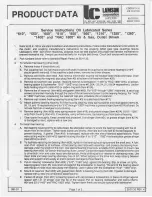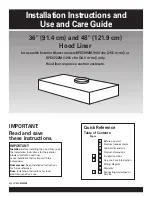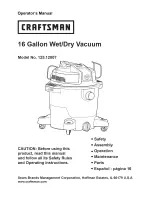
4
2. If possible, discharge the air at or towards ceiling levels to mix the supply air with the warmer stratified mechanical room air.
Consideration should be given to the use of ducts and diffusers to evenly distribute the air throughout the mechanical room. NOTE:
Do not discharge air directly across water lines, temperature control devices, or draft hoods/draft controls. If correctly installed no
additional air heating means will be required beyond what heating means would be required for conventional air supply louvers.
3. Give careful consideration to the air inlet opening as it enters the building to connect to the supply duct system. Too high of a cap-
ture velocity can entrain rain or snow into the mechanical room. We recommend a capture velocity no greater than 800 feet per
minute for rain and 650 feet per minute for snow. Capture velocity is calculated by dividing the maximum Cubic Feet per Minute
(CFM) of air by the Square Feet of area it is pulled through. 1000 CFM through a 1' x 2' opening, would have a capture velocity of
500' per minute.
Note:
Inlet screens and louvers are typically not fully open and have an open area percentage. Make sure to add
area to the air opening to compensate for the reduction caused by the screen and/or louver blade.
4. The inlet shape has a bearing on the entrainment and capture velocity of the incoming air. In general, long tapered openings are
preferred to short flat openings. Inlet screening will help spread the velocity more evenly across the air inlet opening.
5. If possible, use gravity to your advantage, rain and snow are harder to pull up than they are to pull sideways. Do not design an inlet
opening that points upwards.
6. Refer to the Industrial Ventilation Manual produced by the American Conference of Governmental Industrial Hygienist or the
ASHRAE Fundamentals handbook for more in depth information.
REQUIREMENTS WHEN USING THE VSUB BLOWER FOR MECHANICAL DRAFT
1. Make sure the VSUB Blower specified is large enough to remove the exhaust gasses for all the heating appliances connected to it.
Tjernlund Products, Inc. is not responsible for vent layout, appliance type or design changes to the heating system.
2.
For Vertical discharges:
The VSUB Blower housing can be rotated to facilitate a vertical discharge. Make sure the clearance to
combustible surfaces inside and outside the building are followed as discussed in your state and local codes or in their absence,
the National fuel gas code NFPA 211 and NFPA 54 or 31. Canadian installations must comply with local codes or in their absence,
the latest edition of the Natural Gas Installation Code (CAN/CGA-B149.1), the Propane Installation Code (CAN/CGA-B149.2) and
the Installation Code for Oil Burning Equipment (CSA Std B139-M91). The VSUB Blower is designed for variable speed applica-
tions and the discharge velocity from the outlet of the blower or vent system can be similar to a conventional chimney.
For Horizontal discharges:
The VSUB Blower can be rotated if necessary to facilitate a horizontal discharge. Make sure the clear-
ance to combustible surfaces inside and outside the building are followed as discussed in your state and local codes or in their
absence, the National fuel gas code NFPA 211 and NFPA 54 or 31. Canadian installations must comply with local codes or in their
absence, the latest edition of the Natural Gas Installation Code (CAN/CGA-B149.1), the Propane Installation Code (CAN/CGA-B149.2)
and the Installation Code for Oil Burning Equipment (CSA Std B139-M91). In addition, we strongly recommend that an exhaust ter-
mination be developed that has an outlet opening at least 1.5 times the area of the outlet area of the VSUB being used. If the dis-
charge opening is screened, verify that the screen does not reduce the open area to less than that of the connected vent pipe. The
termination should not direct the flue gasses down the building exterior and should not face directly into wind. The VSUB is rated to
handle 575°F flue gases. Consider the application temperature when developing the termination.
Never operate a mechanical draft or combustion air system without a proving device that proves the flow of flue gasses and is inter-
locked with all of the heating appliances. If installing a VSUB Blower in conjunction with a CPC-2 controller, the CPC-2 provides the
safety interlock. If installing a VSUB Blower without a CPC-2 controller the PSA-1 fan proving switch must be installed in conjunction
with a UC1 Universal Control and any additional MAC-Series multiple appliance controls necessary to interlock all heaters being vented.
MECHANICAL DRAFT TERMINATION CLEARANCES FOR CANADIAN INSTALLATIONS
In the absence of local codes in Canada, installations must comply with the latest edition of the Natural Gas Installation Code
(CAN/CGA-B149.1), the Propane Installation Code (CAN/CGA-B149.2), the Installation Code for Oil Burning Equipment (CSA Std
B139-M91) or as follows, (See Diagram A).
• A venting system shall not terminate underneath a veranda, porch, or deck, or above a paved sidewalk or a paved driveway
that is located between two buildings, and that serves both buildings.
• The exit terminals of mechanical draft systems shall not be less than 2.13m (7ft) above grade when located adjacent to a paved
sidewalk or driveway.
• A venting system shall not direct flue gases towards brickwork, siding, or other construction, in such a manner that may cause
damage from heat or condensate from the flue gases.
• A venting system shall not direct flue gases so as to jeopardize people, overheat combustible structures, or enter buildings.
A venting system shall not terminate within 1.8 m (6ft) of the following:
• A window, door or mechanical air supply inlet of any building, including soffit openings
• A gas service regulator vent outlet
• A combustion air inlet
• A property
line
• A direction facing combustible materials or openings of surrounding buildings
A venting system shall not terminate within 1m (3ft) of the following:
• Above a gas meter/regulator assembly within 1m (3ft) horizontally of the vertical centreline of the regulator
• A oil tank or an oil tankfill inlet
A venting system shall not terminate within .3m (1ft) of the following:
• Above grade level or any surface that may support snow, ice, or debris


































